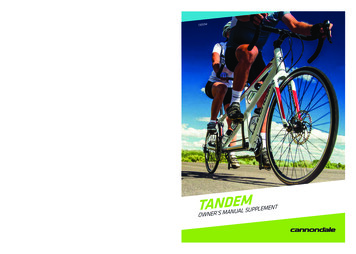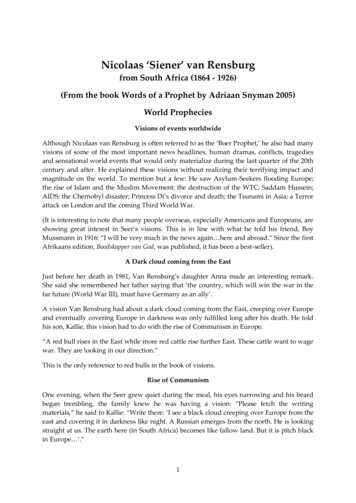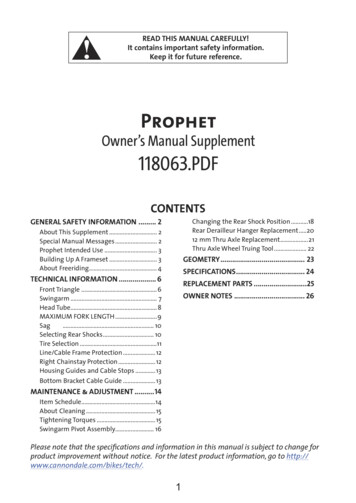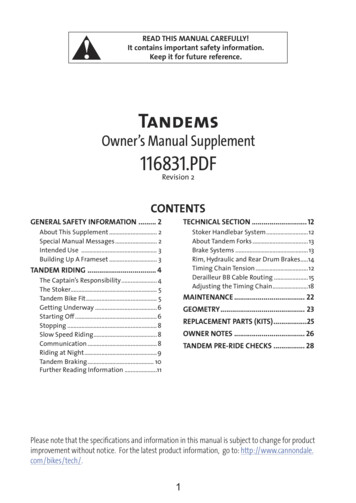
Transcription
up, Inc.Cycling Sports Groad,172 Friendship Ro , 15522-6600, USAvaniaBedford, PennsylIKE-USA(Voice): 1-800-B6173(Fax): 814-623sportsgroup.comcustserv@cyclingLIALE AUSTRACANNONDAupCycling Sports Grodge RoadUnit 8, 31-41 Bri2048Stanmore NSW8595 4444)2(01 6e:Phon44999585)(01 6Fax:auportsgroup.com.askus@cyclings013 Can OMS Cover TANDEM 130594 2.indd 1up Europe,Cycling Sports Gro0510usmail: Postbrt 27visits: Hanzepooal, Netherlands7570 GC, Oldenza79380(Voice): 41 vicedeskeuroLE JAPANCANNONDABuilding 9F,Namba Sumisorie 1-chome,4-19, Minami Ho550-0015, JapanaakOs,kuhiNis-9390(Voice): LE UKCANNONDAupCycling Sports Groe Fulcrum,Vantage Way, Th12 4NUPoole, Dorset, BH 73228802(Voice): 44 (0)12 336602 72(Fax): 44 non up 2013 Cycling130594 (11/13)Sports GroOWNER’S MANUAL SUPPLEMENTLE USACANNONDALE EUROPECANNONDAB.V.TANDEMr’s manual.bicycle ownecannondaleuryodference.anretmenth for futured this suppleion. Keep boatrmWarning! Reafointyfeimportant saBoth contain130594TANDEMPPLEMENTUSLAUNAOWNER’S M05.11.13 16:37
130594ContentsAbout This SupplementCannondale Owner’s Manual Supplements provideimportant model specific safety, maintenance, andtechnical information. They are not replacements foryour Cannondale Bicycle Owner’s Manual.This supplement may be one of several for your bike.Be sure to obtain and read all of them.If you need a manual or supplement, or have aquestion about your bike, please contact yourCannondale Dealer immediately, or call us at one ofthe telephone numbers listed on the inside cover ofthis supplement.You can download Adobe Acrobat PDF versions ofany Cannondale Owner’s Manuals or Supplementsfrom our website: http://www.cannondale.com/.Please note that the specifications and informationin this manual are subject to change for productimprovement. For the latest product information, goto http://www.cannondale.com .Explicit DefinitionsSAFETY INFORMATION. 2-3TANDEM RIDING.4-8TECHNICAL INFORMATION. 9-15Maintenance .16Your Cannondale DealerTo make sure your bike is serviced and maintainedcorrectly, and that you protect applicable warranties,please coordinate all service and maintenancethrough your authorized Cannondale Dealer.NOTICEUnauthorized service, maintenance, orrepair parts can result in serious damageand void your warranty.In this supplement, particularly importantinformation is presented in the following ways:WARNINGIndicates a hazardous situation which, if notavoided, could result in death or serious injury.NOTICEIndicates special precautions that must betaken to avoid damage.Building Up A FramesetBefore building up a frameset, consult withyour Cannondale Dealer and the componentmanufacturers, and discuss your riding style,ability, weight, and interest in and patience formaintenance. Read and follow the componentmanufacturer’s warnings and instructions.p/n 130954Revision A, 11/131
safety informationTandems are Different fromSingle Rider BikesWARNINGTANDEMS ARE BIGGER, HEAVIER, AND LESSMANEUVERABLE THAN SINGLE RIDER BIKES. Ride very cautiously as your team climbs thetandem learning curve. More time is needed to react and avoidride hazards. Always think further ahead. Allow more time.Learn to anticipate hazards.Tandem riding, like any bicycle riding carries arisk of serious injury, paralysis or death.Tandem Specific Forks OnlyThe front fork of your Cannondale Tandem isspecially designed to be much much stronger thana regular bike fork. One of the reasons it is muchstronger is that braking a tandem subjects the frameand fork to tremendous stresses. Ordinary forks canbuckle or fold under tandem braking conditions.Any fork used on your tandem must be designedand intended specifically for tandem use!!WARNINGConfirm with all component manufacturer’sthat the components chosen are designed andintended for use on a tandem bike and intendedfor your weight and riding style.Tandems weight more and often are riddenfaster than single bikes so many componentsmust be designed for higher speeds andlarger loads.Both riders can be seriously injured, paralyzed,or killed In a resulting accident if you ignore thiswarning.2
130594Checking the Stoker Handlebar System“MINIMUM INSERT” markSADDLE CLAMP BOLTSee post.STEM SEATPOSTCLAMP BOLTS8 Nm, 71 In LbsCAPTAIN’S SEATPOSTHANDLEBARCLAMP BOLTSEXTENSION BOLTSSTOKERHANDLEBAR STEM8 Nm, 71 In LbsSEAT BINDER BOLT6 - 8 Nm6 Nm, 53 In LbsWARNINGTO PREVENT THE STOKER HANDLEBAR SYSTEM DETACHING, MOVING, ROTATING, OR TWISTINGUNEXPECTEDLY OR SUDDENLY WHILE RIDING :Before Each Ride: Check all bolts. Use a torque wrench when tightening the bolts of the stoker/captainseat post and handlebar assemblies. Follow the manufacturer’s torque instructions for your particularhandlebar/stem/seat post components.At Least Annually: Remove, clean and inspect the captains seat post. Replace it with a new one if it isdamaged. Also, clean and inspect the Stoker’s handlebar assembly. Make sure it is in good condition.Replace it with a new one if it is damaged.EXTENSION: If the stoker handlebar assembly is the extension type, never extended it beyond the“MINIMUM INSERT” or MAXIMUM EXTENSION” line.If you do not understand these instructions or are unable to complete them as described, please have theperformed by a professional bike mechanic.Both riders can be seriously injured, paralyzed, or killed in a resulting accidentif you ignore this warning.3
TANDEM RIDINGCAPTAINSTOKERThe Tandem PartnershipTandems are fun, and with two engines for the same frontal area, they’re considerably faster than singlebikes. Tandem teams learn to ride together well, to communicate without words, and to anticipate eachother’s desires. Tandeming is a great way to enjoy cycling with another person.Tandems are serious business too. One rider (CAPTAIN) is entirely responsible for the well-being of the otherrider (STOKER). The bike is bigger, heavier, and less forgiving of sloppy riding habits. A tandem captain can’tbe as spontaneous as a rider on a single, nor can the captain make the same kinds of last-minute recoveriesfrom errors in judgment. Look farther ahead, plan farther ahead.Also, be aware that tandems attract attention. People will stare, wave, shout. Passing cars, temporarilydistracted, will often swerve in or out. The presence of a tandem can make people act differently on the road.A bell or airhorn can be very handy in traffic.4
130594The Captain’s ResponsibilityThe captain’s primary job is to make the stoker happy. With an unhappy stoker, the captain won’t havea riding partner! So you must reassure your partner with careful, methodical riding habits. Anticipatemaneuvers, beginning them far in advance. Be alert to shifting needs. A too-fast or too-slow cadence isdoubly annoying to the stoker because she/he can’t fix it. Watch the road or trail ahead, and make yoursteering and braking corrections smoothly.Ride slightly farther from the curb, or from parked cars, than you would on a single bike. Your stoker doesn’twant to feel hemmed in. If you ride too far to the right, you may find your stoker leaning to the left, trying toveer away from the curb.When you conduct a maneuver, such as merging across traffic to make a left turn or steering around apothole, make your decision early. Signal your intentions clearly, proceed on a straight path, and completethe maneuver. A decisive captain will ride smoother, and that will make the stoker happier.Most new tandemists find captaining exhausting, and they get sore shoulder muscles from being tense. Thistoo will pass. As you become accustomed to the requirements of captaining a tandem, you’ll develop alight touch.Don’t hot dog. If your stoker is nervous, ride slowly. In time, the stoker may become more confident and askfor more speed. But if she/he wants to go slow, go slow! The more conservative voice must prevail. That’sonly fair. Remember, you’re the chauffeur, not the stunt pilot.The Stoker : The Best Seat in The HouseThe back seat on a tandem is the fun seat. You have this person in front of you who’s giving all his/herattention to making you feel comfortable. The view is terrific out to the sides, just like on a train ride. Theview to the front may be a bit bland, but the captain’s jersey pockets are a great place to put your fruit bars,and other hedonistic goodies.Your obligations are few: Pedal—at an agreed-upon effort level. Pedal smoothly, so your pedaling doesn’tmake your upper body move around. Don’t shift your upper body weight abruptly. (Your weight shift caninadvertently steer the bike, and force the captain to fight you.) Hold your head high and enjoy the scenery.Tell your captain what she/he is missing while she/he keeps eyes glued to the road for potholes.Many tandem teams delegate hand turning signals to the stoker. This not only encourages communicationbetween the stoker and the captain, it also allows the captain to concentrate on the steering and brakinginvolved in making the maneuver.Every successful stoker learns to delegate authority. The captain steers. The captain decides when to pedaland when to coast. When coasting, the captain decides where to position the pedals. Never fight the captainon these matters. She/he is busy giving you a great ride so you can enjoy yourself.5
Tandem Bike FitIn addition to sizing and comfort issues for each individual, the bicycle must be made to accommodate theinteraction between the two riders. This document is meant to offer hints and suggestions but only scratchesthe surface of tandem setup. The best configuration for any pair of cyclists on a tandem will be the result ofexperimentation. You should investigate the pros and cons of any setup decisions by first consulting withpeople or publications which are knowledgeable about tandem bicycles. See page 8.The captain should fit the tandem as she/he would fit on a single bike. But on a tandem, it’s doublyimportant to have 2-3 inches of crotch clearance for the starting and stopping maneuvers described below.The stoker uses the same seat-to-pedals distance as on a single bike. But the handlebars will be closer (whichis okay, since the stoker doesn’t need to steer).Getting UnderwayAllow time for a complete Pre-Ride Inspection. See your Cannondale Bicycle Owner’s Manual for overall bicyclepre-ride checks. See the Maintenance section of this supplement for Tandem checks.Starting OffStarting and stopping a tandem is smooth and easy, but only if you do everything in the exact prescribedorder. Start by shifting the bike into a comfortably low gear.The captain mounts first. Before, and only before anyone gets on the bike, it can be leaned over to lower theclearance to straddle the bike. Swing your leg forward over the handlebars, not back over the rear of the bike.There might be a person standing there!) Straddle the top tube, plant your feet on the ground, and spreadyour legs to clear the pedals. Firmly hold the bike upright and squeeze both brakes.Never let the bike lean to the side, particularly after the stoker gets on. This is the biggest difference betweenyour tandem and your single. (Your single is so light that you don’t think twice about leaning it. The tandem isnot only heavy, it’s top heavy. Once you let it lean a little, the stoker’s weight makes it want to lean more. Andthe stoker just hates the way that feels.)The stoker gets on now. Because the captain is holding the bike rock solid, the stoker can mount it like ahorse. Put one foot on a pedal and swing your other leg rearward over the saddle. Now the stoker puts bothfeet in the toe clips or clipless pedals. When you’re ready, the stoker backpedals so the captain’s preferredstarting pedal is in the up position. The stoker says, “ready.”Now the captain can start. Pick up one foot, put it on a pedal, and stand on it while steering straight ahead.(Don’t put your rear end on the seat before starting to pedal, because that could make the bike lean over andwobble, and possibly fall.) After you’ve started the first pedal stroke, get in the saddle, put your other footon the backside of the pedal, and continue pedaling and steering. Don’t worry about the toe clip or cliplesspedals. Let the toe clip scrape the ground. Pedal until you are going comfortably fast (10 mph or so), and thenput your other foot in the toe clip or clipless pedals.6
130594StoppingIf you stop briefly, say, for a traffic light, the captain stops the bike while the stoker stays strapped in. Thecaptain takes one foot off the pedal, dismounts from the seat, and puts the foot on the ground while holdingthe bike absolutely upright. Starting up again is just like your initial start-up. The captain should let the stokerknow what’s happening —talk to one another —no surprises.To stop and dismount, reverse the mounting procedure. The captain gets off the seat, spreads legs to clearthe pedals and brace the bike upright while the stoker climbs off. Then the captain can dismount.Slow Speed RidingTandems are stable and easy to maneuver at slow speeds. But they need a confident captain who doesn’tovercorrect or induce wobbling. A smooth style is the key to good slow-speed riding. After you’ve gotten toknow your tandem well, you’ll find you can make a U-turn on a narrow two-lane road.CommunicationSome tandem teams talk a lot about riding. They inform each other of every bump, every shift, every timethey slow down, every drink from a water bottle. Others almost never talk. They prefer to communicatesilently. Whichever style you pick is up to you. Just pick the one that works for you.One important coordination activity may require talking, at least at first: shifting. The reason: on a single bike,riders intuitively let up on the pedals when they’re shifting. On a tandem, the stoker doesn’t necessarily dothat. This is hard on derailleurs (especially front derailleurs) and may make shifts more difficult. Make sureyou both let up on the pedals during critical shifts. Whether you do that by talking or by the stoker feelingwhen captain is about to shift is up to you.WARNINGGOOD COMMUNICATION BETWEEN THE CAPTAIN AND STOKER INCREASES THE SAFETY AND ENJOYMENT OF THE RIDE.MIS-COMMUNCIATION OR POOR COORDINATION INCREASES THE CHANCE OF BEING INVOLVED IN AN ACCIDENT.NEW TANDEM RIDERS:Before riding on a more challenging course, choose an open area free of hazards to practice and develop good Tandemcommunication skills.7
Riding at NightMost of tandem safety comes from good technique, which we’ve described above. A few specific warningsmerit mention, though.Riding a tandem at night is legal if you have a headlight and taillight—but we don’t recommend it. Nighttimeriding is more mentally demanding than day time riding. Tandem riding is more mentally demanding thansingle riding. A tandem at night adds up to too much demand, and too small a margin for error. A tandem is apleasure vehicle, so use it during day—the most pleasant time to ride.See your Cannondale Bicycle Owner’s Manual for moreimportant safety information on riding at night.Further Reading & Information:This supplement can’t cover everything you might want to know about tandeming. For additional informationon riding technique, we suggest you contact: Talk to an Authorized Cannondale Dealer with Tandem expertise. Tandem Club of America, c/o Jack & Susan Goertz, 2220 Vanessa Dr., Birmingham, AL 35242, 205-991-7766, e-mail: tca of a@mindspring.com.Their magazine, Doubletalk, and attendance at TCA events will make you an expert. Besides, TCA events,such as the various regional tandem rallies, are lots of fun. Local tandeming/bicycling clubs in your area have many helpful people. Ask your Authorized Cannondaleretailer to put you in touch with them. The Tandem Scoop, the only book about tandeming we know of, contains extensive instructions onsmooth technique, racing, touring, and dirt riding, riding with children, blind and disabled stokers, andother subjects. (By John Schubert, published by Burley Designs, Eugene, Oregon, 1996. Paperback, 9.ISBN 0-9637190-0-9) 8The Tandem Book, The Complete Guide to Buying, Riding and Enjoying Tandem Bicycles. (By AngelRodriguez and Carla Black, 14.95, available from Adventure Cycling, 800-721-8719 8am.-5pm. M-F Mtn.Time, or www.adv-cycling.org)
130594TECHNICAL INFORMATIONDEGHOPHIBLKASIZES (IN/CM)ABCDEFGHIJKLMN0PQRSSeat Tube AngleHead Tube AngleHorizontal Top Tube LengthMeasured SizeHeadtube LengthChainstay LengthFork RakeBottom Bracket HeightWheelbaseTrailStandover at Top Tube MidpointBottom Bracket DropFront Center DistanceCSMGeometryJQFRROAD 700CNMOUNTAIN 29RM/SL/SX/SJ/MMDLG73.0 ***73.0*73.0 ***73.0*71.0 ***72.5*22.5/57.123.0/58.5 23.6/60.0 24.6/62.528.5/72.5 HH29.1/73.823.2/59.0 24.4/62.028.5/72.5 29.1/73.818.0/45.7 19.0/48.3 21.0/53.3 /20.05.1/13.05.9/15.017.8/45.2***18.9/48.0 ***11.2/28.5*70.7/179.5 71.3/181.0 71.9/182.7 73.4/186.571.3/181.2 73.0/185.52.6/6.6*2.7/6.9H27.7/70.329.9/75.9 31.0/78.7 31.9/80.929.1/74.030.2/76.725.7/65.2 26.5/67.3 27.8/70.6 .6***3.3/8.5*24.5/62.225.7/65.2**24.6/62.4 25.1/63.9 25.8/65.5 26.8/68.19
SpecificationsMODELROAD 700CMOUNTAIN 29RHeadsetCampy style bearings: 41.8mmOD w/ 45 chamfers1.5in or Headshok w/ KP119/SizeM/SL/SX/SJ/MTiming Chain LengthLinks78787879SizeMDLGLinks7879BB ShellFront BB30 Eccentric, Rear BB30 Front BSA Eccentric, Rear BSASeat Post DiameterFront 31.6 mm, Rear 27.2 mmFront Derailleur34.9mmDropout SpacingFront 100 mm, Rear 145 mmRear Brake74mm POST MOUNTWARNINGPlease read your Cannondale Bicycle Owner’s Manual for moreinformation on the following specifications:ASTM CONDTION 1,High-Performance RoadIntended UseMaximum Weight Limit (Lbs/Kg)RIDER (lbs/kg)500 / 227ASTM CONDTION 2,General Purpose RidingLUGGAGE (lbs/kg)75 / 34TOTAL (lbs/kg)575 / 261Replacement PartsCODEDESCRIPTIONCODEDESCRIPTIONA457/KIT,BB CABLEGUIDE,TANDEM; 3 channel BB cableguideKF086/KIT,HYDRAUL. BRK GUIDES,10 PCSQC840/BBQKIT,SEATBINDER,MTN QR,31.8,BLK-STOKERKP230/BB guide for Rear BBQC843/BBQKIT,SEATBINDER,MTN QR,34.9,BLK-CAPTAINA181/KIT,BB ECCENTRIC,TANDEM/1FG; COMPLETEQC841/BBQKIT,SEATBINDER,MTN,31.8,BLK -STOKERKP317/BB30 Eccentric ASSY (QC616, KB6180 not included)QC842/BBQKIT,SEATBINDER,MTN,34.9,BLK -CAPTAINKP103/KIT,BB ECCENTRIC,HWARE -**A181/**KA027/KIT,STEM,STOKER,ADJUSTABLE; FOR USE WITH31.6 SEATPOST AND 31.8 H’BAR DIAMETERKB002/KIT,HEADSET, SI FSA CARBON W/ 15MM TOPCAPKF051/KIT,DER.HANGER;SINGLE SIDED 2KF014/KIT,CABLESTOP, INSERTS - 210KF115/KIT,GEL,DYNAMIC,CARBN SEATPOSTKB6180/KIT BEARING BB SI 2PCSKP018/KIT BEARING BB SI CERAMIC 2PCSQC616/KIT CIRCLIPS (2) BB SIKP009/KIT, ADAPTER, SIBB TO 68MM TAP
130594Rear Derailleur HangerKF051/5.0 Nm, 44 InLbsLoctite 242Rear BB PartsKB6180/BB30 BEARINGKF086/Rear BrakeHousing GuideQC616/CIRCLIPcirclip grooveRear BrakeHousing GuideKP320/REAR BBCABLE GUIDEFront Derailleur(not used)Rear DerailleurKF086/11
Bottom Bracket eccentricYour tandem’s has either, a standard 68mm English threaded BB eccentric, or a BB30 Eccentricassembly (shown next page) depending on the model. Both eccentric types are available fromCannondale. See Replacement Parts.The purpose of an eccentric is to enable rotation of the crankset within the shell for theadjustment of the timing chain, the chain that connect the front BB with the rear BB. Thetiming chain must be of the correct length in order to set the tension with the eccentric. See theSpecifications section for timing chain length for your tandem. Timing chain tension adjustmentis explained on the following pages.FRONT BOTTOM BRACKETBB30 BEARINGA457/Apply bicycle bearing greaseCENTERING BOLTKP317/ECCENTRIC BODY12circlip grooveQC616/CIRCLIPdowelKB6180/BB30 BEARING
FRONT BOTTOM BRACKET130594eccentric MaintenanceBB30 BEARINGAnnually, as part of your regular maintenance schedule, the crankset should be removed from theeccentric and the eccentric assembly removed from the frame. At this time, the eccentric shouldbe disassembled, cleaned and re-greased. The inside the frame BB shell should be cleaned andre-greased as well. The BB30 bearings should be inspected for proper function and replaced withnew ones if damage is indicated.Apply a a high-quality bicycle bearing grease to the mating surfaces of the eccentric, the wedgesA457/and inside the frame shell. grease will to help ensure that the eccentric can be rotated within theshell easily.Eccentric maintenance should only be performed by a professional bike mechanic.Apply bicycle bearing greaseCENTERING BOLTKP317/ECCENTRIC BODYcirclip grooveQC616/CIRCLIPdowelKB6180/BB30 BEARINGslotWASHERWASHERWEDGE(Non-Drive Side)WEDGE(Drive Side)THREAD CAPFIXING BOLT13 Nm, 115.5 In LbsLoctite 242 (blue)3 Nm, 26.5 In LbsLoctite 242 (blue)13
Adjusting The Timing Chain TensionPeriodically, the tension of the timing chain must be checked. The tension should be maintained at 1/2” of total verticaldeflection. Normal chain wear and stretch will cause the tension to change over time.How to adjust the timing chain tension:1. Clean and lubricate the timing chain. Cleaning and lubricating the chain will give result in the best measurement.Ask your Cannondale Dealer about chain care and available products (tools, cleaners, lubricants).2. MEASURE THE TENSION - On the upper length of the chain in the middle of the front and rear timing chainrings, movethe chain up and down. You should be able to lift it up 1/4” and move it down 1/4.” This is 1/2” vertical deflection.6.4mm (1/4")6.4 mm (1/4")Turn the crank to rotate the wheel so you can check the chain tension at different links of the chain at the samemidpoint. If the chain seems tighter in some places, it may be an indication of chain damage or some other problem.Have the chain replaced or the damage repaired before attempting any adjustment. If the chain is in good conditioncontinue to step 3.3. ADJUST THE TENSION - Insert a 4 mm Allen key through the thread cap into the eccentric fixing bolt and turn it counterclockwise to loosen the eccentric. After the first turn or so, the wedge bolt will feel loose then it may seem to tighten as itpushes the wedge backward freeing up the eccentric to rotate in the BB shell. When the wedge is loose and the eccentricassembly is free to rotate within the bottom bracket shell , insert the end of an Allen key into one of the eccentric holesand rotate it until the correct vertical chain deflection is reached. See next figure. The centering bolt of the eccentriclocates on the face of the bottom bracket shell on the drive side to center the assembly. The centering bolt is not anadjustment; do not remove it.4. RETIGHTEN THE FIXING BOLT - When the chain tension is set, tighten the wedge bolt to the specified torque.WARNINGINCORRECT CHAIN TENSION ADJUSTMENT CAN CAUSE YOU TO HAVE AN ACCIDENT. A chain that it too loosecan come off and a chain that is too tight can bind, break or accelerate wear on other parts . Both conditionscan lead to an accident. If you do not understand these instructions or are unable to complete them asdescribed, please have the performed by a professional bike mechanic.14
130594TIMING CHAINFRONTTIMINGCHAINRINGINCREASE TENSIONALLEN KEY HOLESWEDGEDECREASE TENSIONFIXING BOLTLoctite 242 (blue)13 Nm, 115 In LbsCENTERING BOLTCorrect place to inspect tension is at the midpoint between the front and rear timing chainrings.Figure 5.15
MAINTENANCEThe following table lists only supplemental maintenance items. Please consult your Cannondale BicycleOwner’s Manual for more information on basic bike maintenance. Consult with your Cannondale Dealer tocreate a complete maintenance program for your riding style, components, and conditions of use. Follow themaintenance recommendations given by the component manufacturers for the various non-Cannondale partsof your bike.ITEMFREQUENCYCHECK CHAINS, DERAILLEURS, HEADSETS AND TIRES on Tandemsexperience greater wear and tear than on single bikes. These itemsshould be maintained as on your single bike, but more frequently andmore carefully.BEFORE AND AFTER EACHRIDECHECK THE STOKER HANDLEBAR SYSTEM. See page 3.TANDEM TIRE PRESSURE is critical. Low tire pressure invites pinchcut flats, while high pressure improves your performance and makesthe tires last longer. Use the maximum pressure named on the tiresidewall.BEFORE EVERY RIDECHECK CONTROL CABLES are critical. Because of their length ontandems, cables are vulnerable to poor performance friction or poorrouting. Have damaged (worn, frayed, stretched, broken) cablesreplaced with new ones before riding.CHECK THE TIMING CHAIN TENSION - The timing chain—betweenthe two cranksets—is unique to tandems. It stretches in normal use,and must be kept tight. A loose timing chain can flop sideways andsnag a crank arm, or it can come off entirely. See page 14.EVERY FEW RIDESBuy a chain wear indicator to know when to replace both chains. Atandem has a lot of expensive chainwheels and cogs, so the chainwear indicator will quickly pay for itself.WARNINGANY PART OF A POORLY MAINTAINED BIKE CAN BREAK OR MALFUNCTION LEADING TO ANACCIDENT WHERE YOU CAN BE KILLED, SEVERELY INJURED OR PARALYZED. Please ask yourCannondale Dealer to help you develop a complete maintenance program, a program which includes alist of the parts on your bike for YOU to check regularly. Frequent checks are necessary to identify theproblems that can lead to an accident.16
up, Inc.Cycling Sports Groad,172 Friendship Ro , 15522-6600, USAvaniaBedford, PennsylIKE-USA(Voice): 1-800-B6173(Fax): 814-623sportsgroup.comcustserv@cyclingLIALE AUSTRACANNONDAupCycling Sports Grodge RoadUnit 8, 31-41 Bri2048Stanmore NSW8595 4444)2(01 6e:Phon44999585)(01 6Fax:auportsgroup.com.askus@cyclings013 Can OMS Cover TANDEM 130594 2.indd 1up Europe,Cycling Sports Gro0510usmail: Postbrt 27visits: Hanzepooal, Netherlands7570 GC, Oldenza79380(Voice): 41 vicedeskeuroLE JAPANCANNONDABuilding 9F,Namba Sumisorie 1-chome,4-19, Minami Ho550-0015, JapanaakOs,kuhiNis-9390(Voice): LE UKCANNONDAupCycling Sports Groe Fulcrum,Vantage Way, Th12 4NUPoole, Dorset, BH 73228802(Voice): 44 (0)12 336602 72(Fax): 44 non up 2013 Cycling130594 (11/13)Sports GroOWNER’S MANUAL SUPPLEMENTLE USACANNONDALE EUROPECANNONDAB.V.TANDEMr’s manual.bicycle ownecannondaleuryodference.anretmenth for futured this suppleion. Keep boatrmWarning! Reafointyfeimportant saBoth contain130594TANDEMPPLEMENTUSLAUNAOWNER’S M05.11.13 16:37
Tandem teams learn to ride together well, to communicate without words, and to anticipate each other's desires. Tandeming is a great way to enjoy cycling with another person. . A bell or airhorn can be very handy in traffic. stoKeR CAPtAIn. 4 5 130594 the Captain's Responsibility The captain's primary job is to make the stoker happy .










